Quick tests for some Adulterants in foods
Quick tests for some Adulterants in foods
- Milk and Milk Products
- Detection of water in milk
- Detection of detergent in milk
- Detection of starch in milk and milk products (khoya, chenna, paneer)
- Detection of mashed potatoes, sweet potatoes and other starches in ghee/butter
- Oils and Fats
- Sugars and Confectionery
- Food Grains and Its Products
- Detection of extraneous matter (dust, pebble, stone, straw, weed seeds, damaged grain, weeviled grain, insects, rodent hair and excreta) in food grains
- Detection of ergot (a fungus containing poisonous substance) in food grains
- Detection of dhatura in food grains
- Detection of excess bran in wheat flour
- Detection of khesari dal in dal whole and split
- Detection of added colour in food grains
- Detection of iron filings in atta/maida/suji (rawa)
- Detection of turmeric in sella rice
- Detection of rhodamine B in ragi
- Spices and Condiments
- Detection of foreign resin in asafoetida (hing)
- Detection of soap stone or other earthy matter in asafoetida (hing)
- Detection of papaya seeds in black pepper
- Detection of artificial/water soluble synthetic colours in chilli powder
- Detection of cassia bark in cinnamon
- Detection of grass seeds coloured with charcoal dust in cumin seeds
- Detection of argemone seeds in mustard seeds
- Detection of lead chromate in turmeric whole
- Detection of artificial colour in turmeric powder
- Detection of sawdust and powdered bran in powdered spices
- Detection of extraneous matter (dust, pebble, stone, straw, weed seeds, damaged grain, weevilled grain, insects, rodent hair and excreta) in whole spices
- Detection of fennel seeds in cumin seeds
- Miscellaneous
- Detection of malachite green in green chilli and green vegetables
- Detection of artificial colour on green peas
- Detection of coloured dried tendrils of maize cob in saffron
- Detection of white powder in iodised salt
- Differentiation of common salt and iodised salt
- Detection of clay in coffee powder
- Detection of colour in supari pan masala
- Detection of exhausted tea in tea leaves
- Detection of iron filings in tea leaves
- Detection of chakunda beans in pulses
- Detection of rhodamine B in sweet potato
- Detection of wax polishing on apple
- Detection of chicory powder in coffee powder
Milk and Milk Products
Detection of water in milk
Testing method:
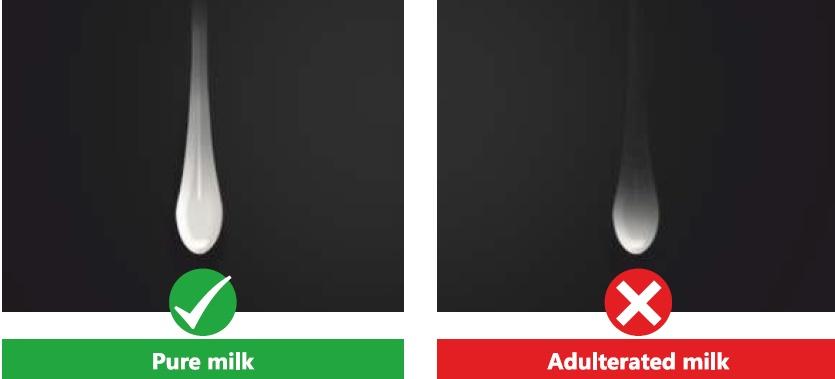 Put a drop of milk on a polished slanting surface.
Put a drop of milk on a polished slanting surface. - Pure milk either stays or flows slowly leaving a white trail behind.
- Milk adulterated with water will flow immediately without leaving a mark.
Detection of detergent in milk
Testing method:
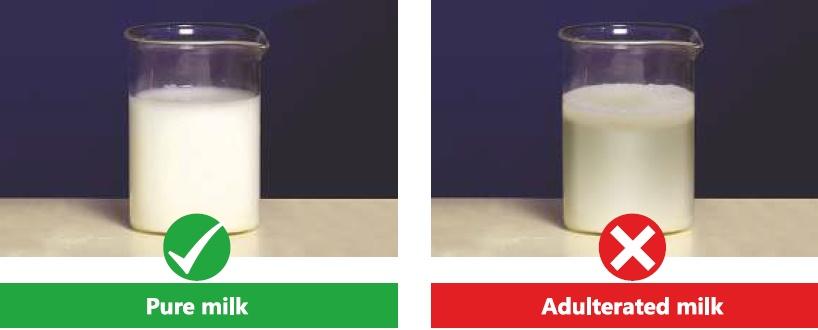 Take 5 to 10ml of sample with an equal amount of Water.
Take 5 to 10ml of sample with an equal amount of Water. - Shake the contents thoroughly.
- If milk is adulterated with detergent, it forms dense lather.
- Pure milk will form very thin foam layer due to agitation.
Detection of starch in milk and milk products (khoya, chenna, paneer)
Testing method:
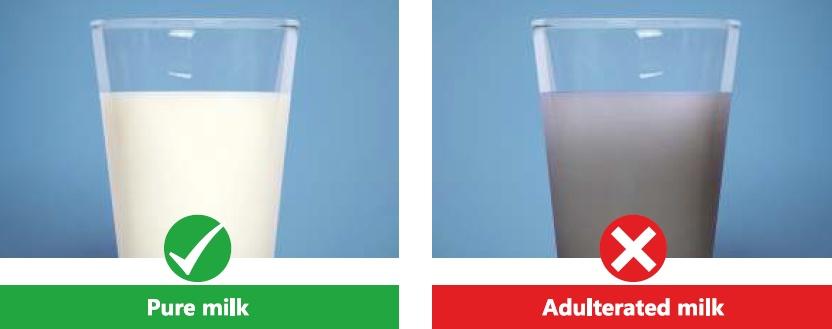 Boil 2 - 3 ml of sample with 5ml of water.
Boil 2 - 3 ml of sample with 5ml of water.- Cool and add 2 - 3 drops of tincture of iodine.
- Formation of blue colour indicates the presence of starch.
(In the case of milk, addition of water and boiling is not required)
Detection of mashed potatoes, sweet potatoes and other starches in ghee/butter
Testing method:
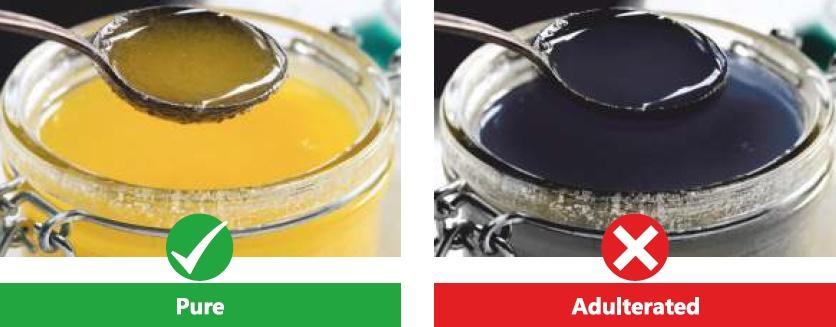 Take ½ teaspoon of ghee/butter in a transparent glass bowl.
Take ½ teaspoon of ghee/butter in a transparent glass bowl.- Add 2 - 3 drops of tincture of iodine.
- Formation of blue colour indicates the presence of mashed potatoes, sweet potatoes and other starches.
Oils and Fats
Detection of other oils in coconut oil
Testing method:
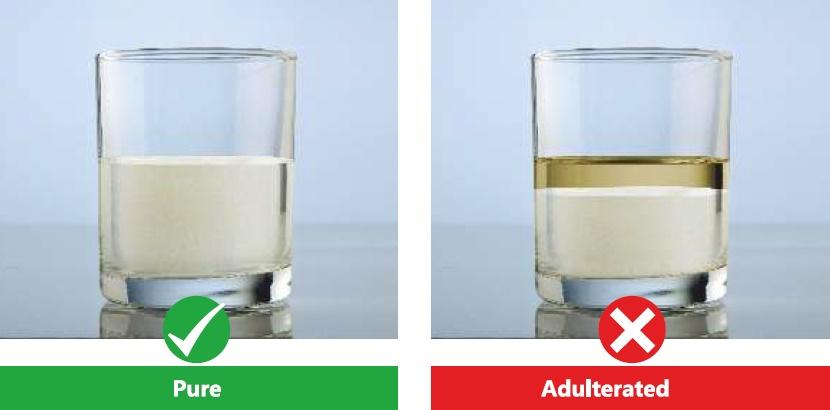 Take coconut oil in a transparent glass.
Take coconut oil in a transparent glass.- Place this glass in refrigerator for 30 minutes. (Do not keep in the freezer)
- After refrigeration, coconut oil solidifies.
- If coconut oil is adulterated, then other oils remain as a separate layer.
Sugars and Confectionery
Detection of sugar solution in honey
Testing method 1:
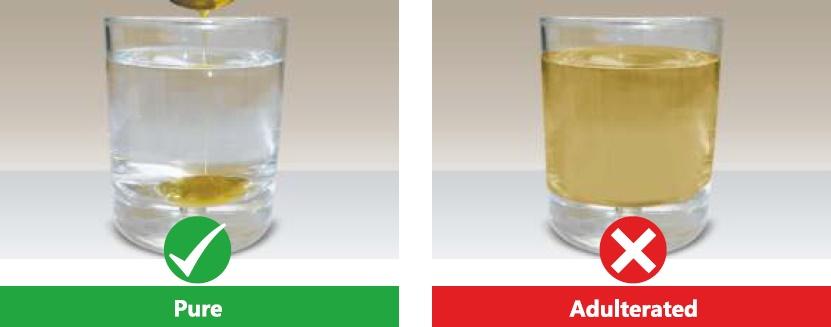 Take a transparent glass of water.
Take a transparent glass of water. - Add a drop of honey to the glass.
- Pure honey will not disperse in water.
- If the drop of honey disperses in water, it indicates the presence of added sugar.
Testing method 2:
- Take a cotton wick dipped in a pure honey and light with a match stick.
- Pure honey will burn.
- If adulterated, the presence of water will not allow the honey to burn if it does; it will produce a cracking Sound.
Detection of chalk powder in sugar/pithi sugar/jaggery
Testing method:
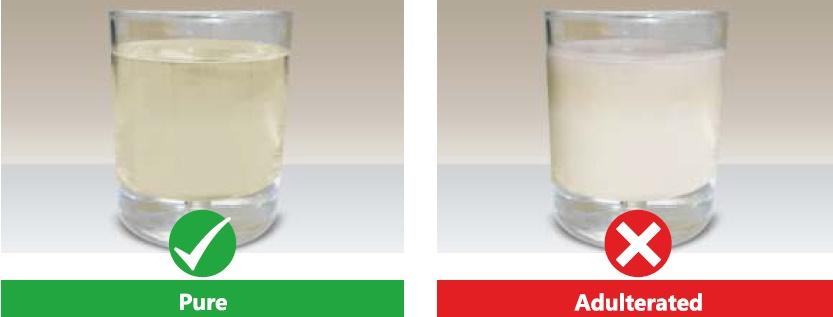 Take a transparent glass of water.
Take a transparent glass of water.- Dissolve 10g of sample in water.
- If sugar/pithi sugar/jaggery is mixed with chalk, the adulterant will settle down at the bottom.
Food Grains and Its Products
Detection of extraneous matter (dust, pebble, stone, straw, weed seeds, damaged grain, weeviled grain, insects, rodent hair and excreta) in food grains
Testing method:
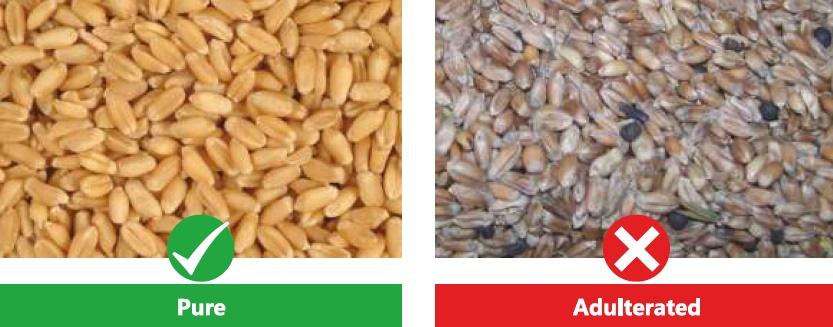 Take Small quantity of sample in a glass plate.
Take Small quantity of sample in a glass plate. - Examine the impurities visually.
- Pure food grains will not have any such impurities.
- Impurities are observed visually in adulterated food grains.
Detection of ergot (a fungus containing poisonous substance) in food grains
Testing method:
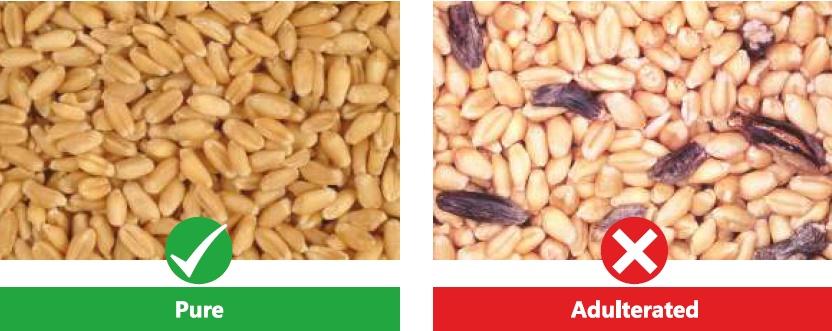 Put some grains in a transparent glass containing 20% of salt solution.
Put some grains in a transparent glass containing 20% of salt solution. - Ergot floats over the surface while sound grains settle down.
- Purple black, longer sized grains show the presence of ergots.
(20g of table salt/iodized salt in 100ml of water)
Detection of dhatura in food grains
Testing method:
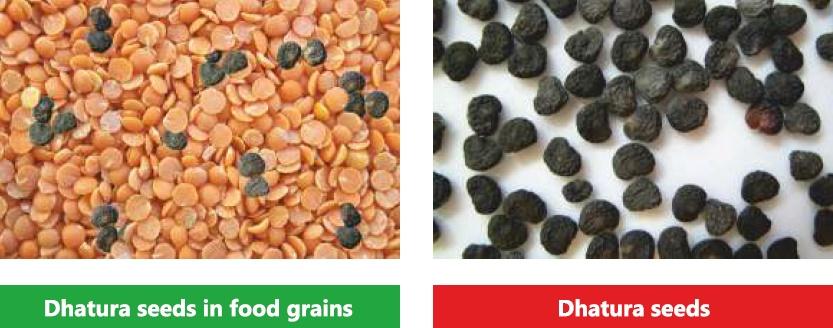 Take small quantity of food grains in a glass plate.
Take small quantity of food grains in a glass plate.- Examine the impurities visually.
- Dhatura seeds which are flat with edges and blackish brown in colour can be separated out by close examination.
Detection of excess bran in wheat flour
Testing method:
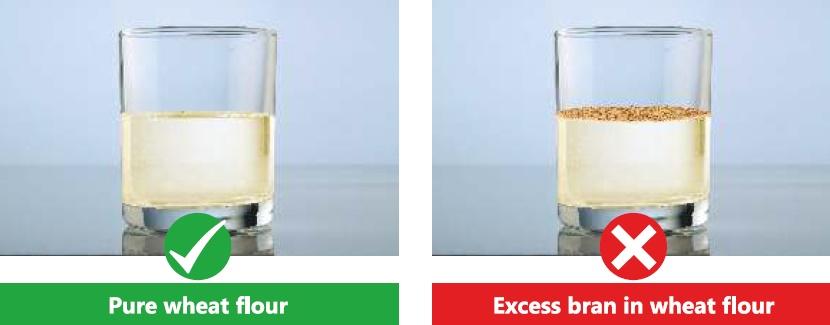 Take a transparent glass of water.
Take a transparent glass of water. - Sprinkle a spoon of wheat flour on the surface of water.
- Pure wheat flour will not show excess bran on water surface.
- Adulterated wheat flour shows excess bran floating on water surface.
Detection of khesari dal in dal whole and split
Testing method:
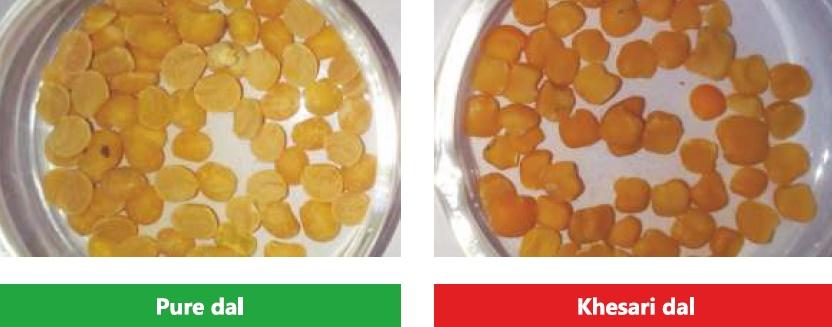 Take small quantity of dal whole or split in a glass plate.
Take small quantity of dal whole or split in a glass plate. - Examine the impurities visually.
- Pure dal will not have any such impurities.
- Khesari dal which has edged type appearance showing a slant on one side
- and square in appearance can be separated out by close examination.
Detection of added colour in food grains
Testing method:
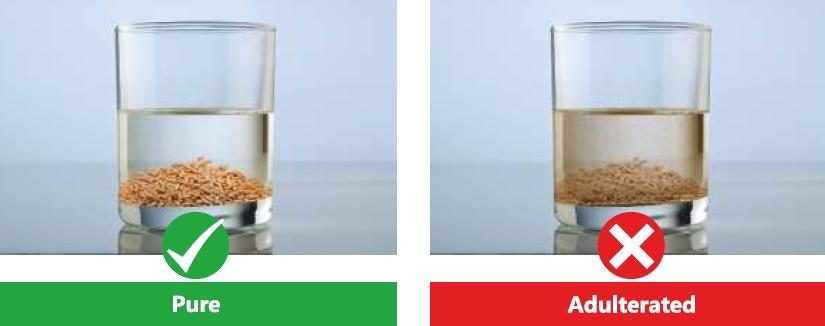 Take a transparent glass of water.
Take a transparent glass of water.- Add 2 teaspoons of food grains and mix thoroughly.
- Pure food grains will not leave any colour.
- Adulterated food grains leaves colour immediately in water.
Detection of iron filings in atta/maida/suji (rawa)
Testing method:
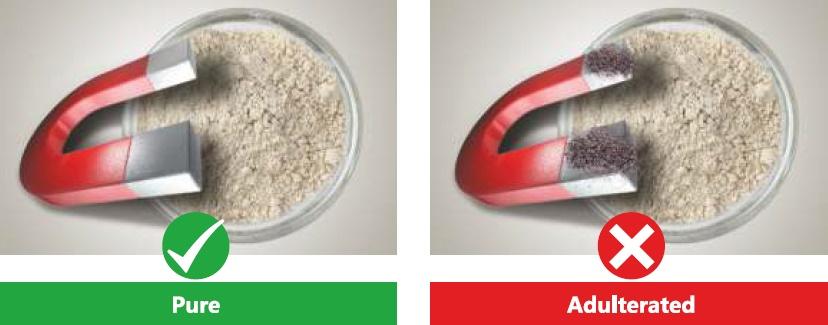 Take small quantity of sample in a glass plate.
Take small quantity of sample in a glass plate. - Move the magnet through the flour.
- Pure flour will not show any iron filings on the magnet.
- If flour is adulterated, then iron filings will be seen on the magnet.
Detection of turmeric in sella rice
Testing method:
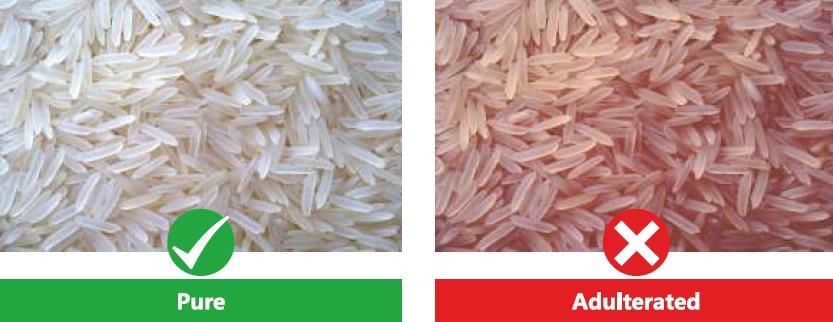 Take a tea spoon of rice in a glass plate.
Take a tea spoon of rice in a glass plate. - Sprinkle a small amount of soaked lime (commonly known as chuna which is used in pan) on the rice grains.
- Pure grains will not form red colour.
- Adulterated grains will form red colour.
Detection of rhodamine B in ragi
Testing method:
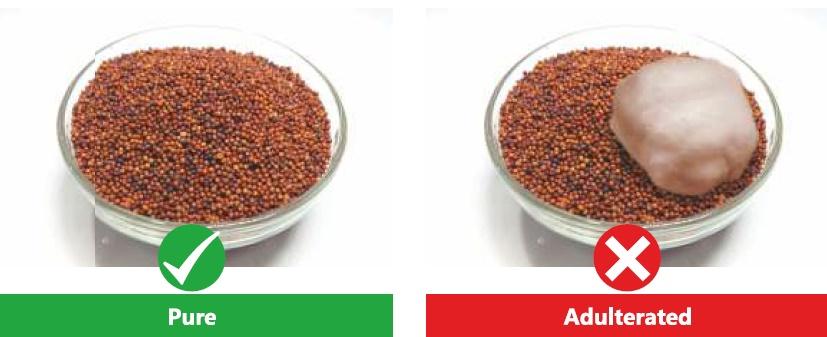 Take cotton ball soaked in water or vegetable oil. (conduct the test separately)
Take cotton ball soaked in water or vegetable oil. (conduct the test separately)- Rub the outer surface of the ragi.
- If cotton absorbs colour, then it indicates the adulteration of rhodamine B for colouring the outer surface of ragi.
Spices and Condiments
Detection of foreign resin in asafoetida (hing)
Testing method:
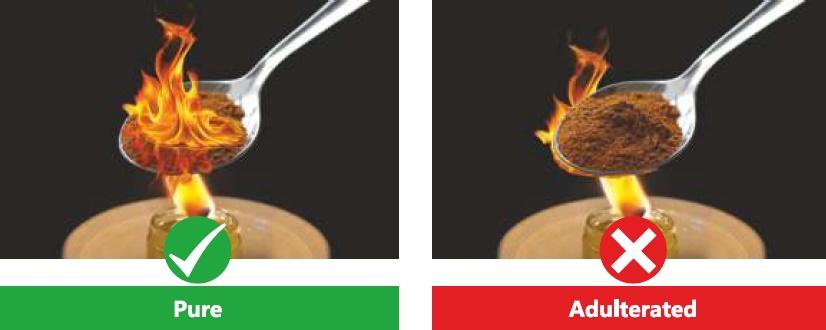 Burn small quantity of asafoetida in a stainless steel spoon.
Burn small quantity of asafoetida in a stainless steel spoon. - Pure asafoetida will burn like camphor.
- Adulterated asafoetida will not produce bright flame like camphor.
Detection of soap stone or other earthy matter in asafoetida (hing)
Testing method:
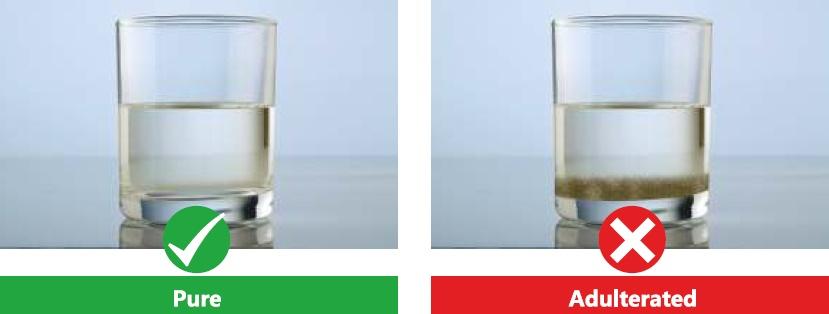 Shake little portion of the sample with water and allow to settle.
Shake little portion of the sample with water and allow to settle. - Pure asafoetida will not leave any soap stone or other earthy matter at the bottom.
- If asafoetida is adulterated, soap stone or other earthy matter will settle down at the bottom.
Detection of papaya seeds in black pepper
Testing method:
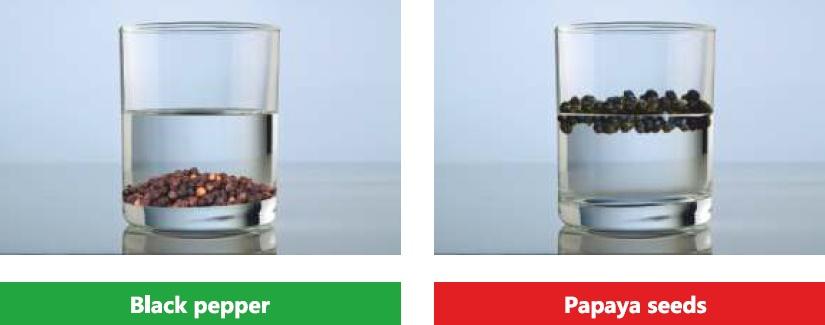 Add Some amount of black pepper to a glass of Water.
Add Some amount of black pepper to a glass of Water. - Pure black pepper settles at the bottom.
- In the adulterated black pepper, papaya seeds float on the surface of Water.
Detection of artificial/water soluble synthetic colours in chilli powder
Testing method:
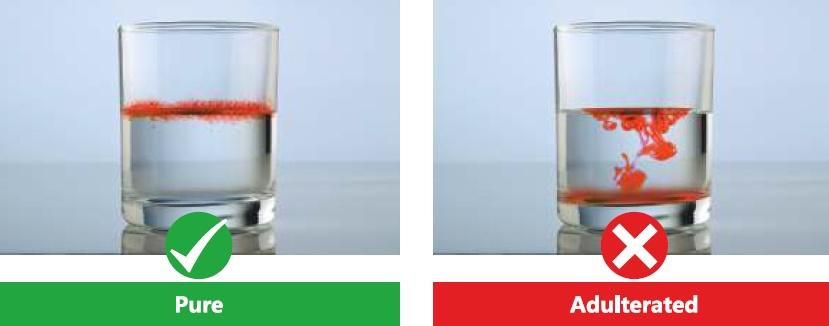 Sprinkle chilli powder on the surface of water taken in a glass tumbler.
Sprinkle chilli powder on the surface of water taken in a glass tumbler. - The artificial colourants will immediately start descending in colour streaks.
Detection of cassia bark in cinnamon
Testing method:
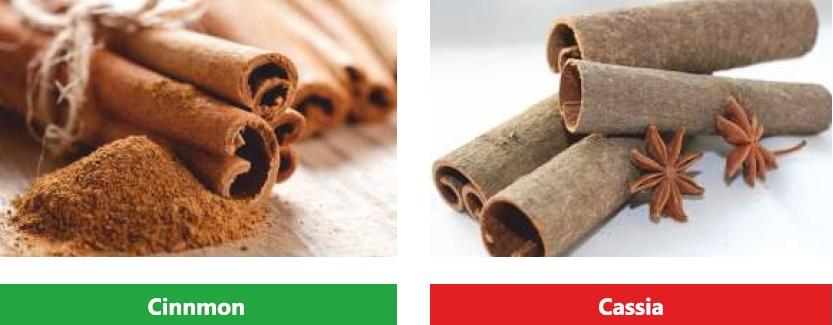 Take small quantity of cinnamon in a glass plate.
Take small quantity of cinnamon in a glass plate.- If adulterated, on close visual examination, cassia bark that comprises of several layers in between the rough outer and inner most smooth layers can be differentiated from cinnamon.
- Cinnamon barks are very thin that can be rolled around a pencil or pen. It has a distinct smell.
Detection of grass seeds coloured with charcoal dust in cumin seeds
Testing method:
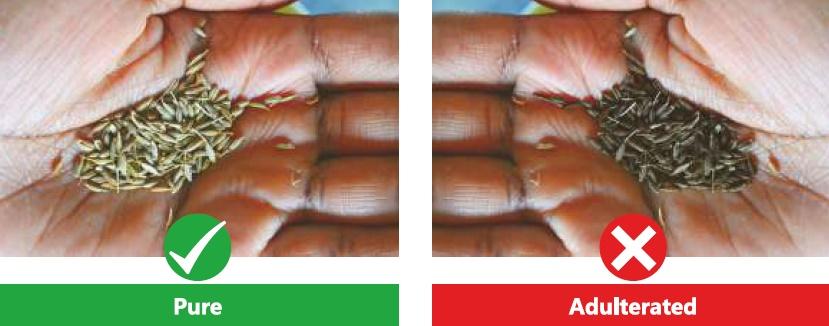 Rub small amount of Cumin seeds on palms.
Rub small amount of Cumin seeds on palms.- If palms turn black, adulteration is indicated.
Detection of argemone seeds in mustard seeds
Testing method:
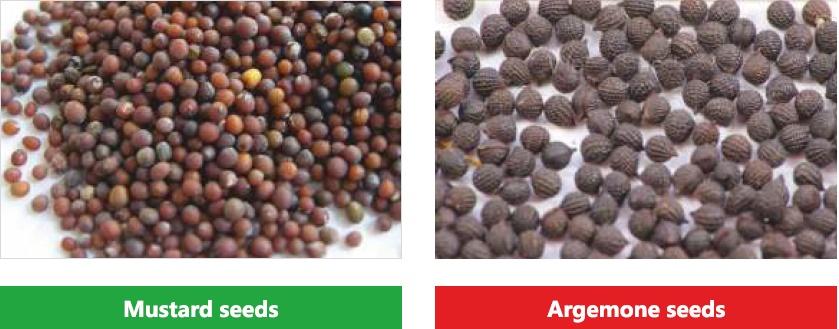 Take Small quantity of mustard Seeds in a glass plate.
Take Small quantity of mustard Seeds in a glass plate. - Examine visually for the argemone seeds.
- Mustard seeds have a smooth surface and when pressed, inside it is yellow in colour.
- Argemone seeds have grainy, rough surface and are black in colour. When pressed, inside it is white in colour.
Detection of lead chromate in turmeric whole
Testing method:
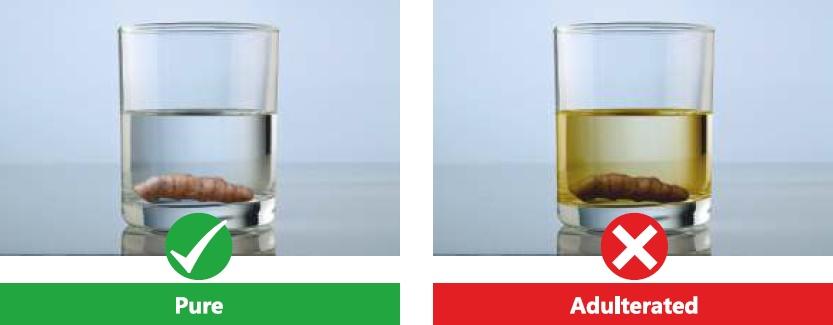 Add small quantity of turmeric whole in a transparent glass of water.
Add small quantity of turmeric whole in a transparent glass of water. - Pure turmeric will not leave any colour.
- Adulterated turmeric appears to be bright in colour and leaves colour immediately in water.
Detection of artificial colour in turmeric powder
Testing method:
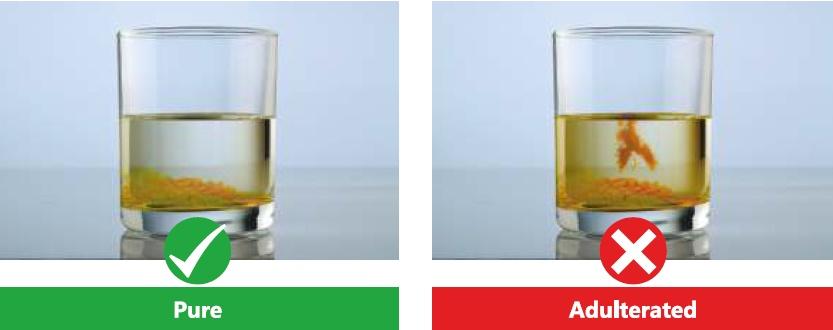 Add a teaspoon of turmeric powder in a glass of water.
Add a teaspoon of turmeric powder in a glass of water. - Natural turmeric powder leaves light yellow colour while settling down.
- Adulterated turmeric powder will leave a strong yellow colour in water while settling down.
Detection of sawdust and powdered bran in powdered spices
Testing method:
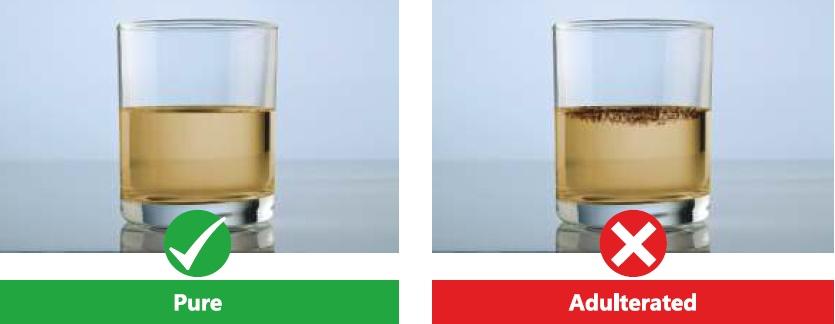 Sprinkle powdered spices on the water surface.
Sprinkle powdered spices on the water surface. - Pure spices will not leave any saw dust/powdered bran on the surface of water.
- If spices are adulterated, saw dust/powdered bran will float on the surface.
Detection of extraneous matter (dust, pebble, stone, straw, weed seeds, damaged grain, weevilled grain, insects, rodent hair and excreta) in whole spices
Testing method:
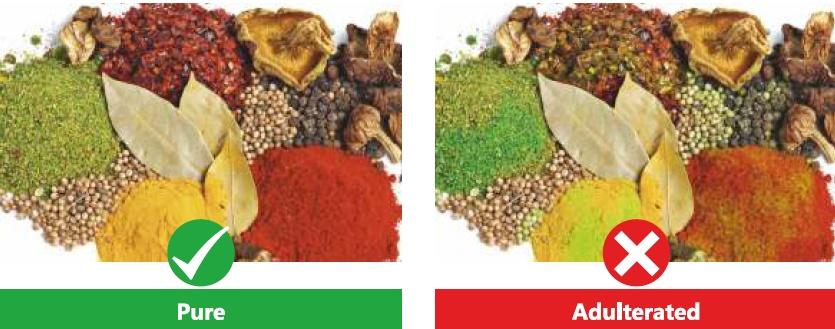 Take small quantity of sample in a glass plate.
Take small quantity of sample in a glass plate. - Examine the impurities visually.
- Pure whole spices will not have any impurities.
- Impurities are observed visually in adulterated whole spices.
Detection of fennel seeds in cumin seeds
Testing method:
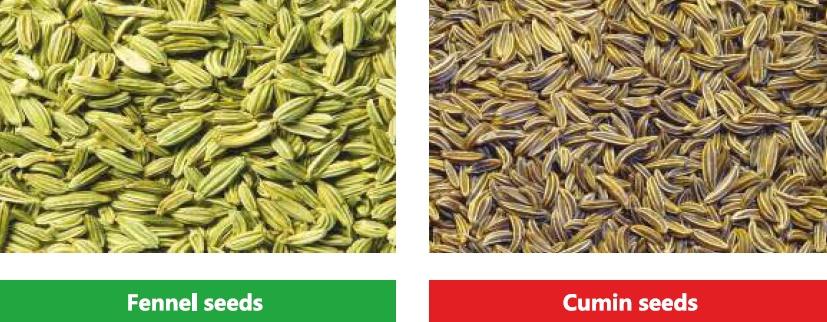 Take small quantity of cumin seeds in a glass plate.
Take small quantity of cumin seeds in a glass plate. - Examine visually for the fennel seeds.
- Fennel seeds can be separated out by close examination.
Miscellaneous
Detection of malachite green in green chilli and green vegetables
Testing method:
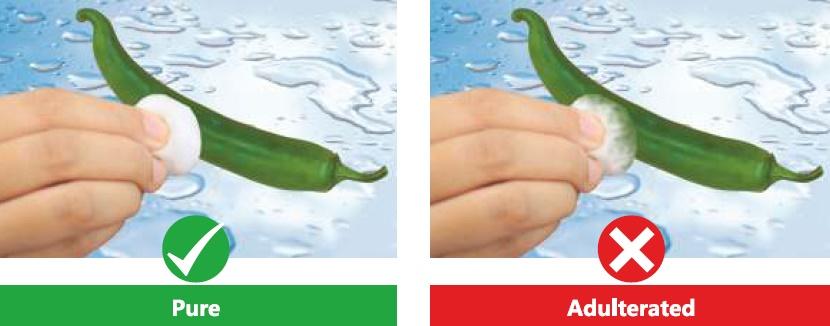 Take a cotton piece soaked in water or vegetable oil. (conduct the test separately) ) Rub the outer green surface of a small part of green vegetable/chilli.
Take a cotton piece soaked in water or vegetable oil. (conduct the test separately) ) Rub the outer green surface of a small part of green vegetable/chilli. - If the cotton turns green, then it is adulterated with malachite green.
Detection of artificial colour on green peas
Testing method:
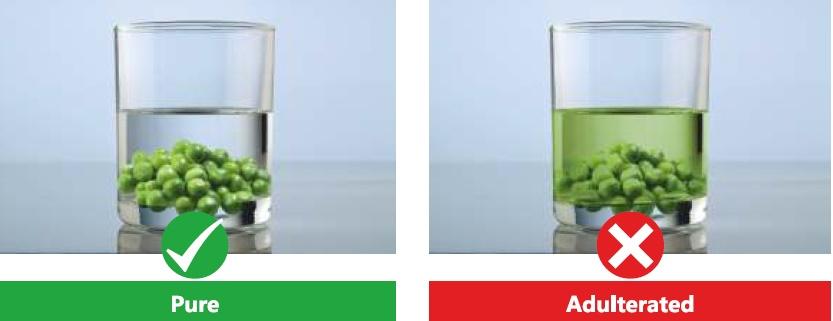 Take little amount of green peas in a transparent glass.
Take little amount of green peas in a transparent glass. - Add water to it and mix well.
- Let it stand for half an hour.
- Clear separation of colour in water indicates adulteration.
Detection of coloured dried tendrils of maize cob in saffron
Testing method:
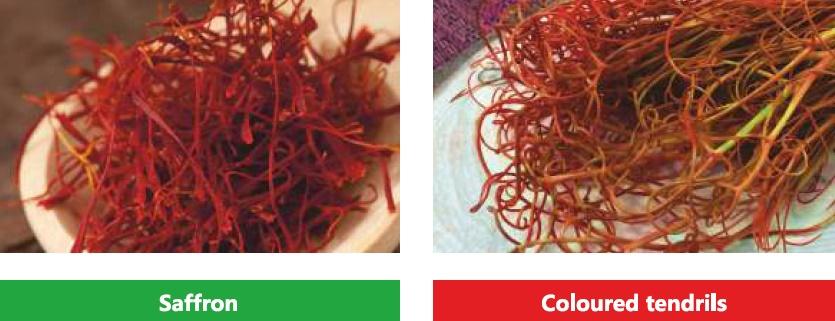 Genuine saffron will not break easily like artificial. Artificial saffron is prepared by soaking maize cob in sugar and colouring it with coal tar.
Genuine saffron will not break easily like artificial. Artificial saffron is prepared by soaking maize cob in sugar and colouring it with coal tar.- Take a transparent glass of water and add small quantity of saffron.
- If saffron is adulterated, the artificial colour dissolves in water rapidly. A bit of pure saffron when allowed to dissolve in water will continue to give its saffron colour so long as it lasts.
Detection of white powder in iodised salt
Testing method:
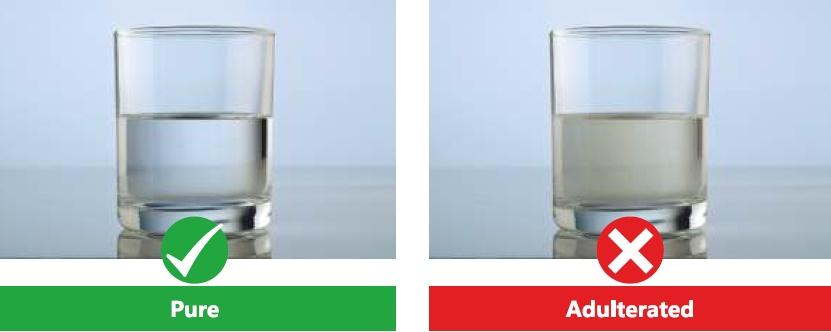 Stir ¼ teaspoon of sample of salt in a glass of water.
Stir ¼ teaspoon of sample of salt in a glass of water.- Pure salt dissolves completely and gives a clear solution or gives slightly turbid solution due to the presence of permitted anticaking agent in the salt.
- If salt is adulterated, solution turns dense white turbid in the presence of chalk powder and other insoluble impurities will settle down at the bottom.
Differentiation of common salt and iodised salt
Testing method:
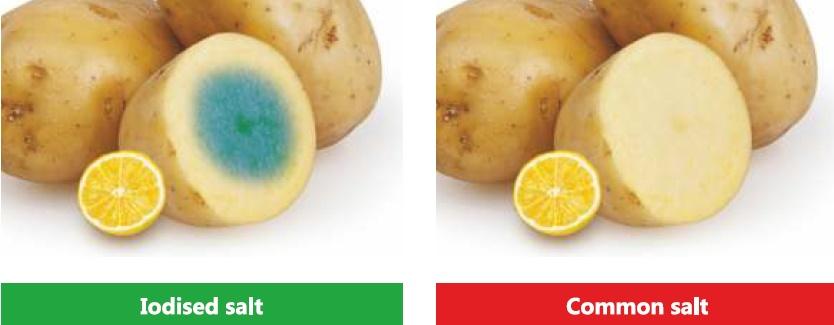 Cut a piece of potato, add salt and wait for a minute.
Cut a piece of potato, add salt and wait for a minute. - Add two drops of lemon juice.
- If it is iodised salt, blue colour will develop.
- In the case of common salt, there will be no blue colour.
Detection of clay in coffee powder
Testing method:
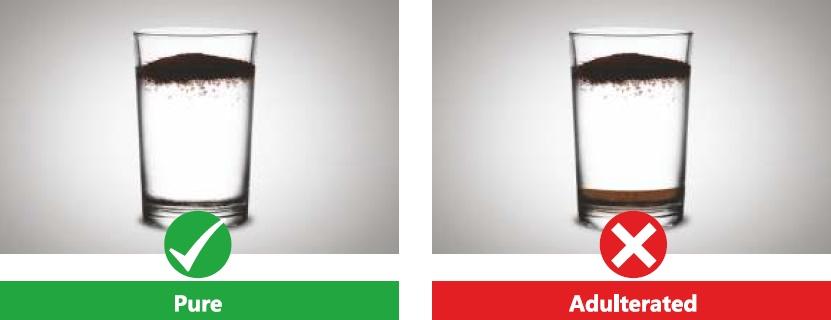 Add ½ teaspoon of coffee powder in a transparent glass of water.
Add ½ teaspoon of coffee powder in a transparent glass of water. - Stir for a minute and keep it aside for 5 minutes. Observe the glass at the bottom. Pure coffee powder will not leave any clay particles at the bottom.
- If coffee powder is adulterated, clay particles will settle at the bottom.
Detection of colour in supari pan masala
Testing method:
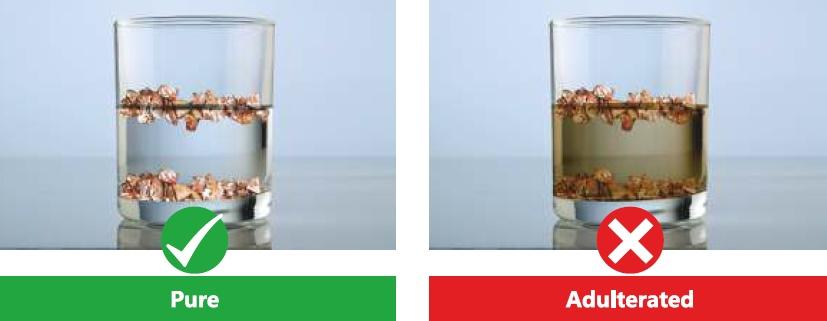 Add small amount of supari pan masala in a glass of water.
Add small amount of supari pan masala in a glass of water. - Pure supari masala will not leave any colour in water.
- If adulterated, then colour dissolves in water immediately.
Detection of exhausted tea in tea leaves
Testing method:
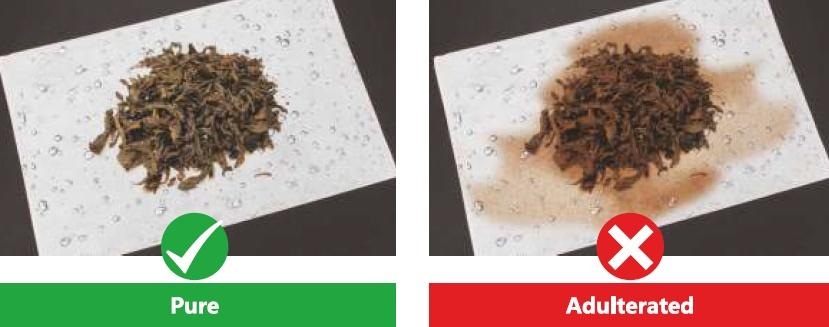 Take a filter paper and spread few tea leaves.
Take a filter paper and spread few tea leaves. - Sprinkle with water to wet the filter paper.
- Wash the filter paper under tap water and observe the stains against light.
- Pure tea leaves will not stain the filter paper.
- If coal tar is present, it will immediately stain the filter paper.
Detection of iron filings in tea leaves
Testing method:
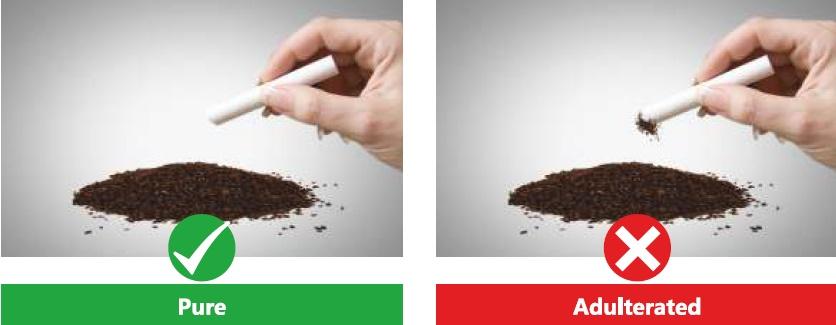 Take small quantity of tea leaves in a glass plate.
Take small quantity of tea leaves in a glass plate. - Move the magnet through the tea leaves.
- Pure tea leaves will not show any iron filings on the magnet.
- If adulterated, then iron filings will be seen on the magnet.
Detection of chakunda beans in pulses
Testing method:
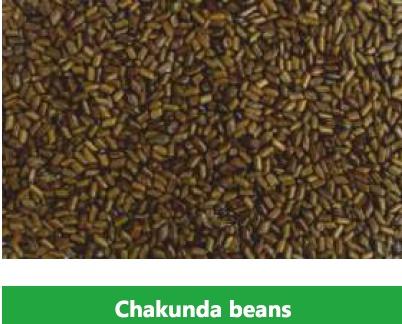 Take small quantity of pulses in a transparent glass plate.
Take small quantity of pulses in a transparent glass plate. - Examine the impurities visually.
- Chakunda beans can be separated out by close examination.
Detection of rhodamine B in sweet potato
Testing method:
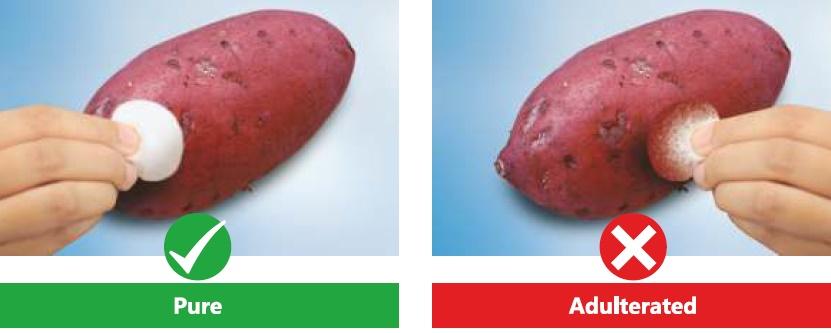 Take a cotton ball soaked in water or vegetable oil. (conduct the test separately)
Take a cotton ball soaked in water or vegetable oil. (conduct the test separately)- Rub the outer red surface of the sweet potato.
- If cotton absorbs colour, then it indicates the usage of rhodamine B for colouring the outer surface of sweet potato.
Detection of wax polishing on apple
Testing method:
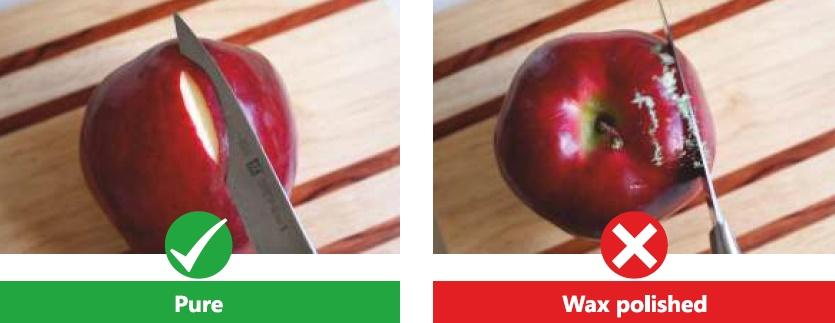 Take a blade and scratch the surface of the apple.
Take a blade and scratch the surface of the apple.- Wax comes out if wax polishing has been done.
Detection of chicory powder in coffee powder
Testing method:
- T
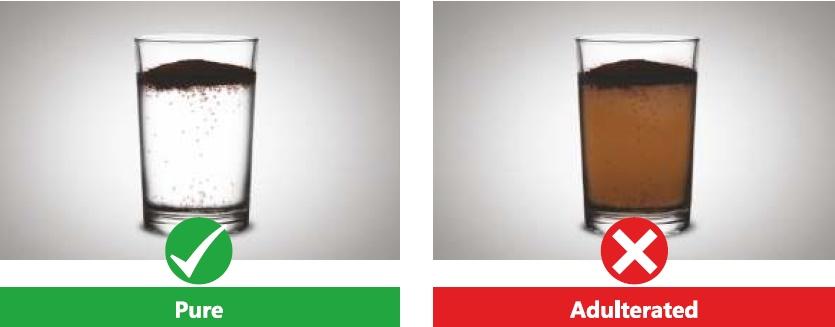 ake a transparent glass of water.
ake a transparent glass of water. - Add a teaspoon of coffee powder.
- Coffee powder floats over the water but chicory begins to sink.
Last Modified : 7/3/2023
This topic provides information about frequently a...
This topic covers the Information related to the M...
